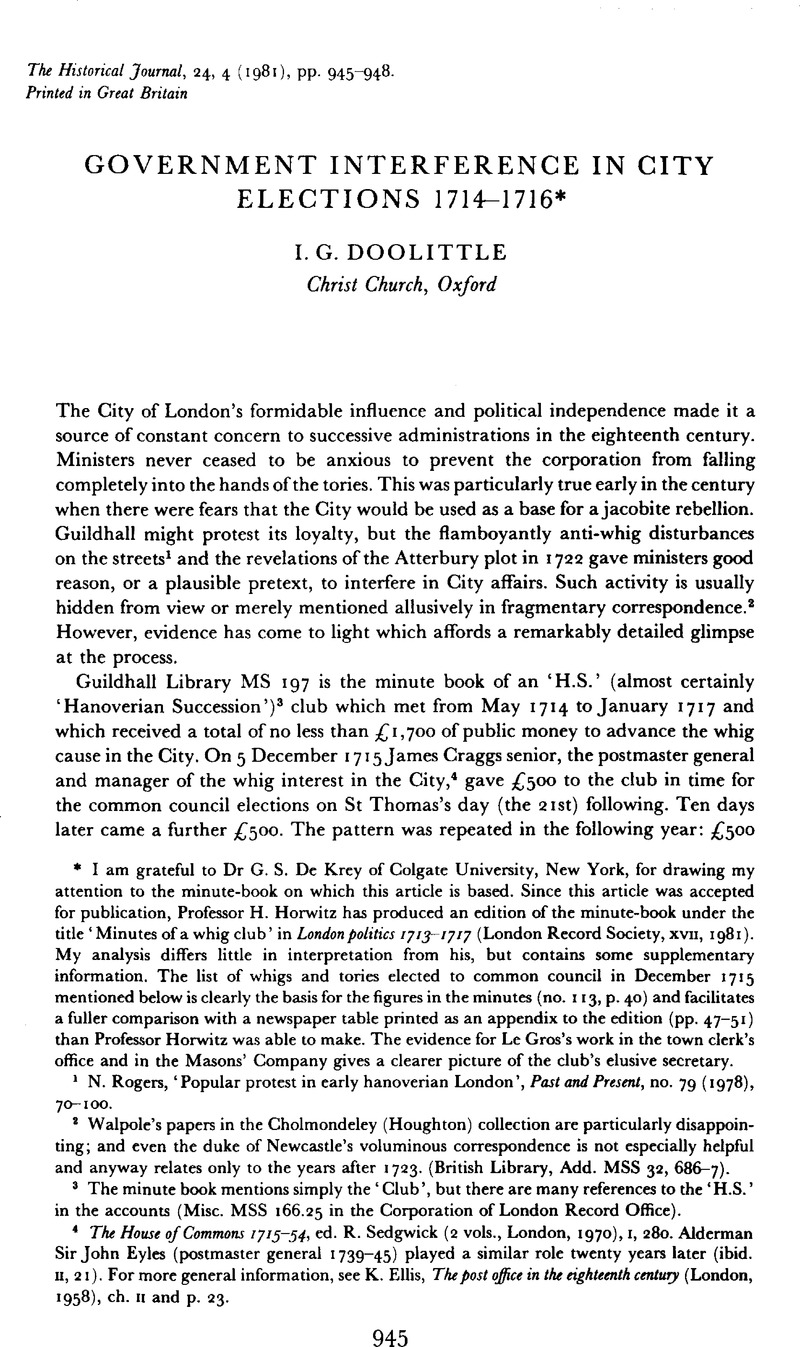No CrossRef data available.
Article contents
Government Interference in City Elections 1714–1716*
Published online by Cambridge University Press: 11 February 2009
Abstract

- Type
- Communications
- Information
- Copyright
- Copyright © Cambridge University Press 1981
References
1 Rogers, N., ‘Popular protest in early hanoverian London’, Past and Present, no. 79 (1978), 70–100.CrossRefGoogle Scholar
2 Walpole's papers in the Cholmondeley (Houghton) collection are particularly disappointing; and even the duke of Newcastle's voluminous correspondence is not especially helpful and anyway relates only to the years after 1723. (British Library, Add. MSS 32, 686–7).
3 The minute book mentions simply the ‘Club’, but there are many references to the ‘H.S.’ in the accounts (Misc. MSS 166.25 in the Corporation of London Record Office).
4 The House of Commons 1715–54, ed. Sedgwick, R. (2 vols., London, 1970), 1, 280Google Scholar. Alderman Sir John Eyles (postmaster general 1739–45) played a similar role twenty years later (Ibid. a, 21). For more general information, see Ellis, K., The post office in the eighteenth century (London, 1958), ch. 11 and p. 23.Google Scholar
5 Receipts in the unsorted accounts.
6 Minute book, pp. 37–9, 41, 42, 50, 76–7, etc.
7 The diary of Dudley Ryder 1715–16, ed. Matthews, W. (London, 1939), p. 153.Google Scholar
8 C.L.R.O., Repertory of the court of aldermen 121 p. 222. (The Guildhall Library catalogue suggests that the hand is that of John Smart, another important City official. The hand is similar, it is true, but it is not Smart's.) Le Gros's work in Gibson's office is revealed by his extracts and notes to be found in ‘Collect[io] ex Iib[ris] et rec[ordis] civitatis London’ (C.L.R.O., 33 c), torn. I. Internal evidence makes it plain that the material in the volume was compiled for Gibson from similar manuals belonging to former town clerks (see the note by Le Gros in item 46 p. 16 and his endorsement of item 11). Guildhall Library MS 94 is a companion volume; it too contains entries by Le Gros.
9 Conder, E. (junior), Records of the hole crafte and fellowship of masons (London, 1894), p. 304. Le Gros is noted as an assistant of the company as late as 1731 (p. 301).Google Scholar
10 Acres, W.M., The bank of England from within, 1694–1900 (2 vols., London, 1931), 11, 632Google Scholar. His death is reported in the Gentleman's Magazine, xiii (1743), 443; and his unilluminating will is in the Public Record Office, PROB 11/728/267.Google Scholar
11 Accounts, 25 Dec. 1715 and 24 June 1716. For meetings at the Crown, see the minute book, pp. 78, 103.
12 The accounts include, for instance, payments for binding various ‘Influence books’.
13 Minute book, pp. 123 ff.
14 Ibid. p. 82.
15 Ibid. pp. 34, 43, 87, 106.
16 ‘Collectio ex libris’, I, item 40. Item 41 is also in Le Gros's hand. It is part of a list of the City's inhabitants dated 1713, and it may have been used for electioneering purposes, C.L.R.O. MS 83.3 should also be noticed. Le Gros's hand appears on a list of those in Walbrook ward, possibly with a view to jury service (as the catalogue suggests), but perhaps with voting qualifications in mind. (My attention to this last source was drawn by a reference in Rogers, N., ‘London politics from Walpole to Pitt: patriotism and independency in an era of commercial imperialism 1738–63’ (Toronto Univ. Ph.D. thesis, 1974), p. 22 ii. 28 (p. 38).)Google Scholar
17 These figures exclude a number of tories whom the Club conceded were ‘to be continued’.
18 C.L.R.O., Journal of common council 56 fo. 217–18, 219.
19 The Rev. M. Wood to the Rev. S. Carte, 24 Dec. 1716, Carte MSS, Bodleian Library, Oxford, 244 fo. 196-v.
20 In 1719, for example, ‘the D(uke) of Newcastle & Mr Craggs came down in person’ for an aldermanic election (Wood to Carte, 3 Feb. 1719, Ibid. fo. 88). In the 1720s Walpole and Newcastle worked closely with the whig aldermen to mitigate the worst excesses of tory insolence (as may be traced at first-hand in the New castle papers and at one remove in Henderson, A.J., London and the national government 1721–42 (Durham, N.C., 1945)).Google Scholar
21 I have traced the activities of two of these agents, Thomas Woodford (solicitor to the East India company) and Joseph Bell (comptroller of the inland post at the post office) in appendix VII in ‘The government of the City of London 1694–1767’ (Oxford Univ. D. Phil, thesis, 1980). Both had been members of the H.S. club.Google Scholar
22 In 1737 Joseph Bell and another post office official, councilman Daye, John, clearly had money to spend on common council elections. Daye and Bell to [Walpole], 23 Dec. 1737, Cambridge Univ. Library, Cholmondeley (Houghton) MSS, correspondence no. 2718.Google Scholar (Daye may have been a former member of the H.S. club.)
23 Bishopsgate was said to have been selected as a test case. A furious contest ensued. A compleat collection of all the letters, reports, songs, etc. that have been published on the opposition of the present common-council-men of Bishopsgate ward... (London, 1740). (Bodleian Library, Gough London158 (8))Google ScholarRogers, Cf. N., ‘Resistance to oligarchy: the City opposition to Walpole and his successors 1725–47’, London in the age of reform, ed. Stevenson, J. (Oxford, 1977), p. 10.Google Scholar




